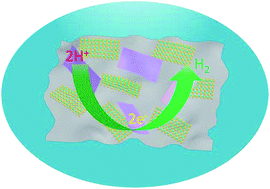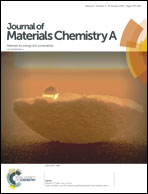MoS2–MoP heterostructured nanosheets on polymer-derived carbon as an electrocatalyst for hydrogen evolution reaction†
Abstract
Electrocatalytic production of hydrogen from water is a promising and sustainable strategy. In this study, a simple and general strategy is demonstrated for the synthesis of a polymer-derived, heteroatom-doped carbon supporting MoS2–MoP nanosheets (MoS2–MoP/C), which acts as an efficient hydrogen evolution reaction (HER) catalyst. The unique composition of the MoS2–MoP/C enables catalysis of HER, demonstrating a Tafel slope of 58 mV dec−1 and overpotentials of 102 mV and 130 mV, and is therefore able to deliver current densities of 10 mA cm−2 and 20 mA cm−2, respectively. Moreover, the MoS2–MoP/C nanosheets demonstrate superior long-term durability in acid electrolytes and the developed strategy is easily adapted to large-scale production of efficient electrocatalysts. This excellent HER performance is likely attributed to electronic interactions between P and S, a relatively-high specific surface area of the electrocatalyst (162 m2 g−1), the characteristic nanosheet morphology, and high electrical conductivity, which promotes rapid charge transport and collection.



 Please wait while we load your content...
Please wait while we load your content...